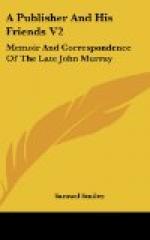Byron and Southey were asked to sit for their portraits to Phillips. Though Byron was willing, and even thought it an honour, Southey pretended to grumble. To Miss Barker he wrote (November 9, 1815):
“Here, in London, I can find time for nothing; and, to make things worse, the Devil, who owes me an old grudge, has made me sit to Phillips for a picture for Murray. I have in my time been tormented in this manner so often, and to such little purpose, that I am half tempted to suppose the Devil was the inventor of portrait painting.”
Meanwhile Mr. Murray was again in treaty for a share in a further work by Walter Scott. No sooner was the campaign of 1815 over, than a host of tourists visited France and the Low Countries, and amongst them Murray succeeded in making his long-intended trip to Paris, and Scott set out to visit the battlefields in Belgium. Before departing, Scott made an arrangement with John Ballantyne to publish the results of his travels, and he authorized him to offer the work to Murray, Constable, and the Longmans, in equal shares.
In 1815 a very remarkable collection of documents was offered to Mr. Murray for purchase and publication. They were in the possession of one of Napoleon’s generals, a friend of Miss Waldie. [Footnote: Afterwards Mrs. Eaton, author of “Letters from Italy.”] The collection consisted of the personal correspondence of Bonaparte, when in the height of his power, with all the crowned heads and leading personages of Europe, upon subjects so strictly confidential that they had not even been communicated to their own ministers or private secretaries. They were consequently all written by their own hands.
As regards the contents of these letters, Mr. Murray had to depend upon his memory, after making a hurried perusal of them. He was not allowed to copy any of them, but merely took a rough list. No record was kept of the dates. Among them was a letter from the King of Bavaria, urging his claims as a true and faithful ally, and claiming for his reward the dominion of Wurtemberg.
There were several letters from the Prussian Royal family, including one from the King, insinuating that by the cession of Hanover to him his territorial frontier would be rendered more secure. The Emperor Paul, in a letter written on a small scrap of paper, proposed to transfer his whole army to Napoleon, to be employed in turning the English out of India, provided he would prevent them passing the Gut and enclosing the Baltic.
The Empress of Austria wrote an apology for the uncultivated state of mind of her daughter, Marie Louise, about to become Napoleon’s bride; but added that her imperfect education presented the advantage of allowing Napoleon to mould her opinions and principles in accordance with his own views and wishes.
This correspondence would probably have met with an immense sale, but Mr. Murray entertained doubts as to the propriety of publishing documents so confidential, and declined to purchase them for the sum proposed. The next day, after his refusal, he ascertained that Prince Lieven had given, on behalf of his government, not less than L10,000 for the letters emanating from the Court of Russia alone. Thus the public missed the perusal of an important series of international scandals.




